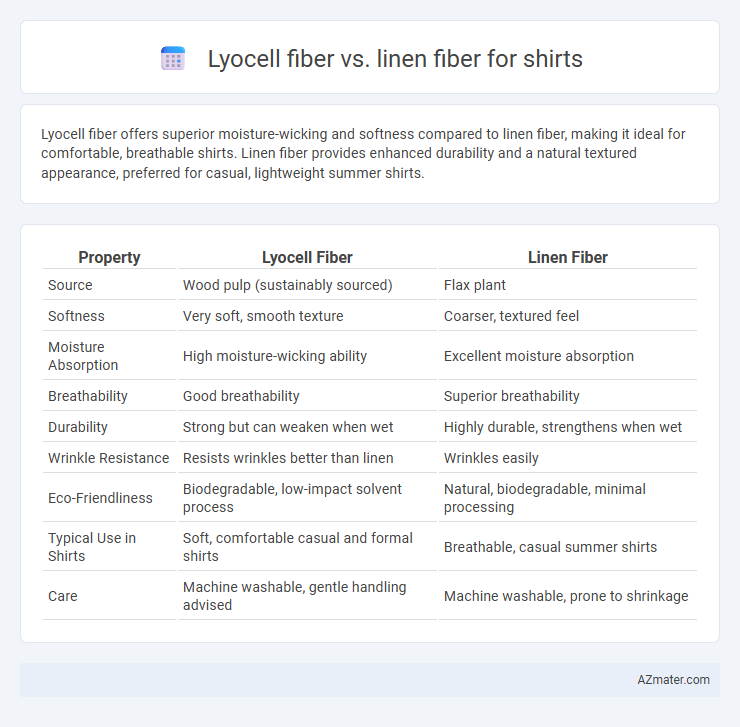Lyocell fiber offers superior moisture-wicking and softness compared to linen fiber, making it ideal for comfortable, breathable shirts. Linen fiber provides enhanced durability and a natural textured appearance, preferred for casual, lightweight summer shirts.
Table of Comparison
| Property | Lyocell Fiber | Linen Fiber |
|---|---|---|
| Source | Wood pulp (sustainably sourced) | Flax plant |
| Softness | Very soft, smooth texture | Coarser, textured feel |
| Moisture Absorption | High moisture-wicking ability | Excellent moisture absorption |
| Breathability | Good breathability | Superior breathability |
| Durability | Strong but can weaken when wet | Highly durable, strengthens when wet |
| Wrinkle Resistance | Resists wrinkles better than linen | Wrinkles easily |
| Eco-Friendliness | Biodegradable, low-impact solvent process | Natural, biodegradable, minimal processing |
| Typical Use in Shirts | Soft, comfortable casual and formal shirts | Breathable, casual summer shirts |
| Care | Machine washable, gentle handling advised | Machine washable, prone to shrinkage |
Overview of Lyocell and Linen Fibers
Lyocell fiber, derived from sustainably sourced wood pulp, offers exceptional softness, moisture-wicking properties, and durability, making it ideal for comfortable and breathable shirts. Linen fiber, harvested from the flax plant, is renowned for its natural strength, high absorbency, and distinctive crisp texture that excels in hot climates. Both fibers provide eco-friendly alternatives with unique benefits, as Lyocell emphasizes smoothness and wrinkle resistance while linen highlights breathability and a textured, classic appearance.
Origins and Production Processes
Lyocell fiber originates from sustainably harvested eucalyptus wood pulp processed through a closed-loop system using non-toxic solvents, yielding a biodegradable and eco-friendly fabric. Linen fiber, derived from the flax plant, undergoes retting, drying, and mechanical processing to extract long, strong bast fibers with minimal environmental impact. Lyocell's chemical spinning contrasts with linen's traditional mechanical extraction, influencing texture, durability, and ecological footprint in shirt manufacturing.
Environmental Impact Comparison
Lyocell fiber is produced using a closed-loop process that recycles water and solvents, resulting in low environmental impact and biodegradability, making it a sustainable choice for shirts. Linen fiber, derived from flax plants, requires minimal pesticides and water, and is fully biodegradable, contributing to its eco-friendly reputation. Comparing both, Lyocell offers efficient resource use in manufacturing, while linen provides a low-impact natural fiber option with reduced agricultural inputs.
Texture and Feel on Skin
Lyocell fiber offers a smooth, silky texture with excellent moisture-wicking properties, making it exceptionally soft and breathable against the skin. Linen fiber provides a crisp, slightly coarse texture that softens over time, delivering a natural, breathable feel ideal for warm weather. Lyocell's gentle touch and moisture management typically outperform linen in comfort for sensitive or dry skin.
Breathability and Moisture Management
Lyocell fiber offers superior moisture management with its high absorbency and ability to wick moisture away from the skin, making it ideal for maintaining dryness and comfort. Linen fiber excels in breathability due to its naturally large fiber diameter and porous structure, allowing excellent air circulation and rapid evaporation of sweat. Both fibers suit warm climates, but Lyocell provides enhanced softness and moisture control, while linen emphasizes airflow and a crisp texture.
Durability and Longevity
Lyocell fiber offers superior durability compared to linen, with its strong, smooth cellulose fibers resistant to wear and tear, maintaining fabric integrity over time. Linen, while naturally strong and breathable, tends to weaken and fray more quickly with repeated washing and heavy use. Shirts made from lyocell fibers generally exhibit extended longevity due to enhanced resistance to shrinking, pilling, and abrasion.
Care and Maintenance Requirements
Lyocell fiber requires gentle machine washing in cold water and should be air-dried or tumble-dried on low heat to maintain its softness and prevent shrinkage, making it low-maintenance and resistant to wrinkles. Linen fiber demands more delicate handling, often recommended for hand washing or gentle machine cycles in cool water, with natural drying to avoid fabric damage and preserve its breathable texture, though it tends to wrinkle easily. Both fibers benefit from ironing for a polished look, but Lyocell fibers typically recover from wrinkles faster than linen, reducing overall maintenance effort.
Style and Appearance in Shirts
Lyocell fiber offers a smooth, lustrous finish with excellent drape, creating shirts that appear sleek and modern while maintaining a soft texture. Linen fiber provides a distinct natural weave with visible slubs, lending shirts a casual, breathable look that emphasizes rustic charm and organic texture. Shirts made from Lyocell often showcase a refined elegance, whereas linen shirts convey effortless style with a slightly wrinkled, relaxed appearance.
Cost and Accessibility
Lyocell fiber for shirts typically costs more than linen due to its eco-friendly production process but offers wider accessibility through mass production channels. Linen fiber is generally less expensive and locally sourced in Mediterranean regions, yet its availability can be limited in markets favoring synthetic blends. Consumers seeking affordable, sustainable shirts might find linen more accessible in some areas, while lyocell provides a premium option with global distribution.
Best Uses for Lyocell vs Linen Shirts
Lyocell fiber excels in moisture-wicking and breathability, making it ideal for activewear and casual shirts designed for warm climates or physical activity. Linen fiber offers superior durability and natural texture, perfect for formal or semi-formal shirts where a crisp, structured appearance is desired. For comfort-driven daily wear that manages sweat well, Lyocell shirts outperform linen, while linen shirts are best suited for stylish, long-lasting garments in hot, dry environments.

Infographic: Lyocell fiber vs Linen fiber for Shirt
 azmater.com
azmater.com